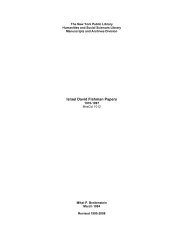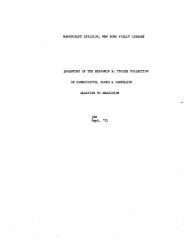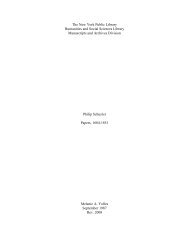pdf available - Multiple Choices
pdf available - Multiple Choices
pdf available - Multiple Choices
You also want an ePaper? Increase the reach of your titles
YUMPU automatically turns print PDFs into web optimized ePapers that Google loves.
son, Asher, would always come to his aid and<br />
find the merchandise.<br />
After Asher got married he opened up a<br />
similar store. The son's store was as disordered as<br />
his father's. Boxes were in the way everywhere,<br />
and buttons lay all over the floor as he ran from<br />
one corner of the store to the other. If his wife was<br />
not in the store, customers would go to Meyertze<br />
Ludmirer or Itche Melnitzer on the other side of<br />
the marketplace.<br />
This is a small picture of a father and son and<br />
not to laugh at, God forbid. Many Jews in other<br />
towns and in other lines ofbusiness used to be like<br />
that. Gifted merchants, brilliant minds, but preoccupied<br />
with God more than with business.<br />
Avrom Buzis<br />
Avrom Buzis was a tratsh [wood cutter]. He<br />
cut boards from round logs, hard work for a Jew.<br />
The work was done mostly in the summer. In the<br />
winter, Avrom would cut oak-bark at my father's<br />
(may he rest in peace) place.<br />
My father dealt in wood for heating homes.<br />
He also sold oak-bark to the tanners who used it<br />
to tan leather.<br />
It took a whole winter to cut the bark, but in<br />
the summertime the bark peeled off more easily<br />
from the oaks in the woods. The season began in<br />
the spring, between Pesach and Shavuot. The<br />
bark was dried in the sun and then stored in<br />
stables built especially for that purpose.<br />
A big, heavy machine stood on the stable's<br />
cement floor. It had a huge wheel made of wood,<br />
which was suspended from a steel axle that rested<br />
on wooden supports. Attached to the axle were<br />
two toothed knives, like a saw. The bark was put<br />
piecemeal under the knives of the machine and<br />
the cut bark fell into a sack that hung underneath.<br />
Avrom Buzis was a middle-aged Jew, with<br />
broad shoulders and a short blond beard. His<br />
short fur-jacket was girt with a rope. He wore<br />
quilted pants and tall boots, which were too big<br />
for him, to leave room for stuffing in more rags<br />
[onetses ] to wrap his feet.<br />
Avrom would get up at dawn. After praying<br />
with the first minyan, he would come to work for<br />
US.<br />
First of all, he would snatch something to<br />
eat. He boiled a pot of water, broke into it small<br />
CHARACTERS AND PERSONALITIES 195<br />
pieces of the Sabbath challah, which was too dry<br />
for easy cutting, and put it into a big earthenware<br />
bowl together with a piece of beef fat and a<br />
handful of salt. When steam came up from the<br />
bowl, he would sit down at the table in a relaxed<br />
manner and begin to work over the bowl, blowing<br />
and eating, eating and sweating. When the bowl<br />
was empty, he would light a bit of machorke<br />
[tobacco, a hand-rolled cigarette] and after resting,<br />
he would come into the shop to work. This<br />
was his first meal of the day.<br />
He was a fast worker. An electric motor could<br />
not beat the speed with which he turned the<br />
handle of the wheel.<br />
His daughter brought him his midday meal.<br />
This second meal consisted of millet with honey,<br />
a dish of sour milk, and half a loaf of bread.<br />
Another "menu" for the second meal was a pot of<br />
potatoes and red borsht made of beets. Usually<br />
after a meal, Avrom blessed the food, thanking<br />
God for giving him sustenance.<br />
After his meal, he went back to the wheel,<br />
working until it got dark. Yes, those Jews of old<br />
were healthy Jews!<br />
Yoneh Ladinyer<br />
Five days a week Yon eh was busy in his flour<br />
mill. Not far from the mill there stood a big house<br />
where his whole family lived, including the sons<br />
and the daughters and their families.<br />
He was called Yoneh Ladinyer because he<br />
came from the village of Ladinye. His real name<br />
was Mel, and mel [flour] did cover his entire face,<br />
his hands, and all his clothes.<br />
Only on two days of the week, on the Sabbath<br />
and on Sunday, did he wear different clothes. We<br />
could then see abit of his face, and his clothes were<br />
a bit darker than during the week.<br />
Yoneh Ladinyer was a simple Jew. But he had<br />
picked as his sons-in-law men who were not so<br />
simple! His oldest son-in-law, Hershele Lifshitz,<br />
was a Jew who knew how to study the sacred<br />
books. I used to meet him at the home of the<br />
Stepenyer rebbe. He would talk and study the<br />
books with the rebbe's son, R. Moyshele, or with<br />
Itche Meyer Shaye Leibushes.<br />
They called him Hershele because he was<br />
short. He had such a long beard that it did not fit<br />
his short stature: it looked as if he had stolen it







